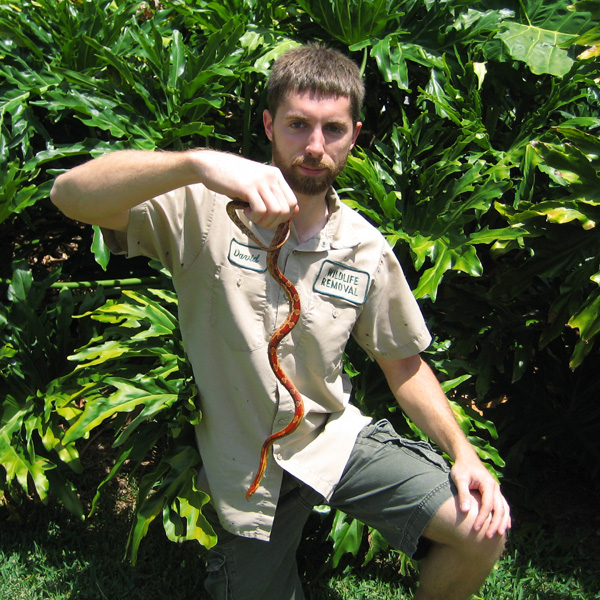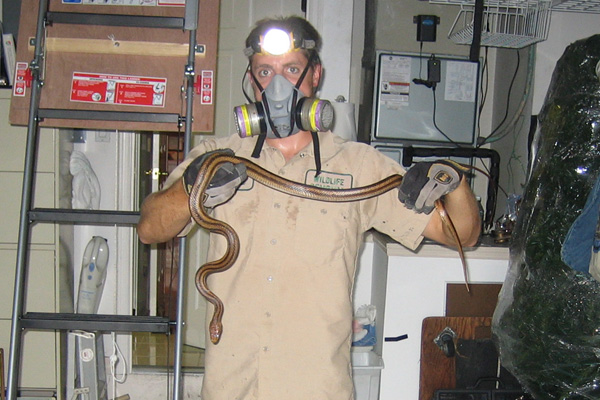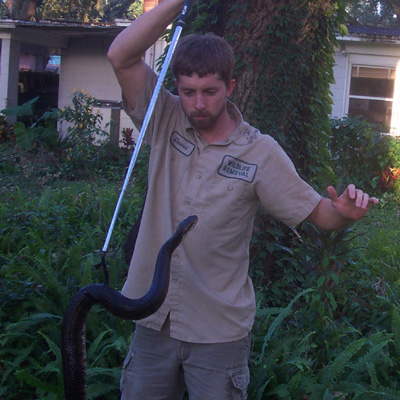- USA Wildlife Removal Education Guide and Resources
How To Get Rid of Snakes Yourself

Seven Steps to Get Rid of Snakes
- 1 - Identify any snake you see before attempting to handle it - never approach a venomous snake.
- 2 - Leave the snake alone - it is probably just passing through, and most snakebites occur when people attempt to catch, kill, or interact with snakes.
- 3 - You can possibly sweep a snake away, or out a door, using a broom.
- 4 - Keep your property well-groomed, and clear of debris. In particular, fill in any ground-level gaps that would make a good snake den.
- 5 - Snake Repellents - they don't work. Go ahead and try them. If they do seem to work, it's because snake sightings are rare to begin with.
- 6 - Use a snake trap - these do work, but I don't consider them very humane.
- 7 - Install a snake fence around the perimeter of the property. This is the only guaranteed way to get rid of snakes in your lawn or property.
A snake in your yard can be harmless or it can be deadly. Knowing how to identify a snake is a very important part of getting rid of it. There is no definitive way of determining if a snake is safe to handle or if it is venomous. Some poisonous snakes resemble harmless snakes, and most homeowners are not schooled in all the nuances of reptile identification. Color alone is not a good indicator, nor are the nursery rhymes taught to use as children about red touching black, and so on. If you have found a snake in your yard and are not one-hundred percent certain of what type it is, call a professional for assistance. Some venomous snakes are common visitors in gardens and are camouflaged enough to remain unseen until they are accidentally grabbed. It is never worth the risk of handling an unidentified snake.


Snakes are not affected by scent deterrents. Avoid wasting your money on mothballs, ammonia, predator urine concoctions and expensive soil additives. These reptiles do have a good sense of smell, but it is not the same sense of smell humans or mammals utilize. A snake's ability to smell assists more in identification of objects rather than acknowledgement of whether an odor is unpleasant. Perimeter barriers can be helpful, but only if the perimeter barrier is a fence. Lengths of coarse rope, gravel strips and sandpaper will not bother a snake at all. The scales on a snake's underbelly are designed for movement along the ground and over objects. Many of these serpents live in the forest where vegetation and rocks can prove to be far more hazardous than any piece of heavy rope.
To get rid of a snake (or snakes) living in your yard, you should trap and remove the snake. There are a number of snake traps on the market, and a professional wildlife expert can help you pick which trap is right for you. The most effective traps are box traps, luring snakes in but preventing them from finding their way out, or trapping them in place with a sticky floor. These traps are hands-free which is very important if you are dealing with a snake that might be venomous.
If a snake is in your home, again identification is vital. A snake in the home has to be removed, either by you or by a professional. If you are certain the snake is not venomous, contain the snake in one room and use a thick blanket to pick the animal up. Place the snake in a pillow case for easy transport. This should never be attempted if you do not know what kind of snake is in your home. Most snakes can strike with amazing speed and height. You should never assume that a snake on the ground will stay on the ground. Snakes that are presumed poisonous should be removed by a professional. Close the snake into one area of the home if possible, sealing any cracks under doors. Wait until help arrives.
Making your yard inhospitable to snakes is an important step in snake prevention. Keep your grass manicured. Snakes like the cool lure of tall grass on a hot day, and the long vegetation also encourages rodents and other snake food sources to multiply. Patios, fences, rock walls, decorative stones and outdoor steps should all be routinely checked for holes that might serves as snake dens. Keeping these areas filled in and maintained will discourage snakes from moving in. If this reptile is a particular nuisance, consider installing a sturdy fence around your property that is flush to the ground.
Go back to the main Snake Removal page for more information about how to get rid of snakes.
How to get Rid of Snakes in the Lawn - If you let your grass grow too long you will eventually have a snake problem. Snakes are very beneficial creatures and do a good amount of rodent and insect control. Having a snake in your yard may not be a bad thing. An overpopulation of snakes can be problematic, and a venomous snake is not something to be trifled with. To get rid of snakes in the lawn, keep your property manicured and picked up. Snakes like to crawl under things to escape the heat of the day. Any stones or items left out in the lawn can become potential snake dens. Snakes are also drawn to water. Keeping your grass cut and your soil dry will help prevent a buildup of insects and rodents and subsequently, snakes. If you have a snake in the yard that has decided to live under the deck, patio or steps and you want to have reptile removed, you can call in a professional or try to trap the snake yourself. Glue traps, especially those with scent lures, can be very effective when trapping a snake. Place the trap near the den and check it daily. Once you have captured the snake it will need to be removed and the crack or hole that served as a den needs to be sealed.
Learn more about snakes through my educational articles about Snake Removal. Read about different species of snakes, including: Copperhead Snake, About Yellow Rat Snakes, and Water Moccasins. Learn about Snake Droppings, the effectiveness of Snake Repellent, and what to do about Snake in Your House, your Attic, and your Basement. Learn how to Identify a Snake and how to Prevent Snakes from getting into your property. Learn what to do about a snake Under a Shed or Deck and how to Trap a Snake. Read if snakes Attract Others and how to Kill a Snake.
Learn how snakes sleep and how snakes smell their environment. Learn about the equipment or tool you need to catch a snake. Learn how snakes produce venom and if snakes can run out of venom. Read about why snakes bite and how snake venom works. I can even let you know how to kill a snake in the yard.
Learn the common snakes from across the country:
Common Snakes of South Carolina
Common Snakes of Texas
Common Snakes of Virginia
Venomous Snakes of Texas
Snake Information
Biology
Snakes are basically legless, elongated reptiles. They do not have eyelids or external ears. Their body is covered with scales and they have a really low metabolic rate. This is why they depend on external heat sources, such as sun-heated rocks, to control the temperature in their body. Their skull has been designed in a way that they can easily swallow a prey which is much larger than their own head, allowing them to unhinge their jaw to make room for larger food. Since, they have a very narrow body which cannot accommodate paired organs side by side, they are present one after the other. Snakes only have one lung. A total of 2,900 species of snakes are known to man and they are found in almost every part of the word. Depending on their species, they can be as small as 10 cm or as large as 25 feet in length. Fossil remains of one species suggests that at one time they were around 49 feet long – that's double the length of largest snake man has found to date in modern times. Snakes are thought to have evolved from aquatic life and adapted themselves to survive on the land. They can be categorized as those carrying venom and those who do not. The species which carry venom uses it to kill its prey and to some extent in self-defense. Others use their strong grip to constrict (boa constrictors for example) and suffocate the prey before swallowing them whole.
Habitat
Snakes are found living in all kinds of environments including water, desert, forests and areas close to human surroundings. They live in trees, in burrows made in ground naturally or by other animals or under the shade of a rock to name a few.
Life Cycle
All snakes employ internal fertilization while the modes of reproduction might be different. The male snake's reproductive organ is in the tail and is in an inverted position. It basically transfers the sperms to the female‘s reproductive opening. Almost all the species lay eggs and then abandon them. The babies are left to fend for themselves from birth. There are, however, a few species such as the King Cobra who build nests and wait until the babies have hatched. A female python stays with the eggs until they hatch and leaves them alone only occasionally when the female goes to drink water or to bask in the sun. She also shivers to generate heat that helps in the hatching process. There are also a few species of snakes that retain eggs in the body and lay them just before the babies are ready to hatch. Some species do not lay eggs but give birth to live snakes. Like humans, they get the nutrient and air supply in the mother's womb.
Diseases they carry
Most people are concerned about venom. But on rare occasion, snakes are the carriers of a number of parasites which are possibly dangerous to human beings and cause a number of health related problems. The parasite protozoa cause diseases related to digestive, respiratory and reproductive system illnesses. Snakes also carry bacteria that cause flues that can damage the urinary and respiratory systems. Tapeworms are parasitic to humans as well and start living in the intestinal tract. Snakes are carriers of Salmonella species of bacteria which results in Salmonellosis outbreaks in humans. The infected person will suffer from symptoms like diarrhea, fever and abdominal cramps. The symptoms might appear after 12 to 72 hours of coming in contact with the bacterium. Salmonella bacteria can be carried by snakes both with and without venom.
The Nuisances of Snakes
Probably the biggest problem caused by snakes is the panic they create just by seeing them. Depending on the species, some snakes prey on smaller animals like hens or small pets. A few cases of loss of electric power have occurred when snakes touch the live and ground wires together. This causes a lot of economic damage and, interestingly enough, the cases have increased over 10 times in last twenty years.

